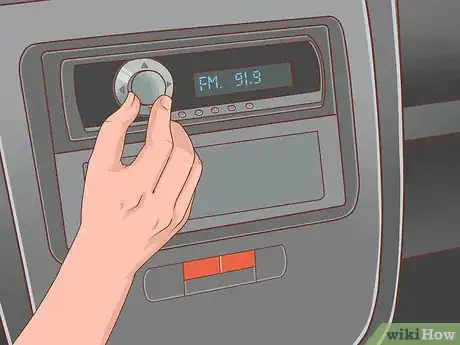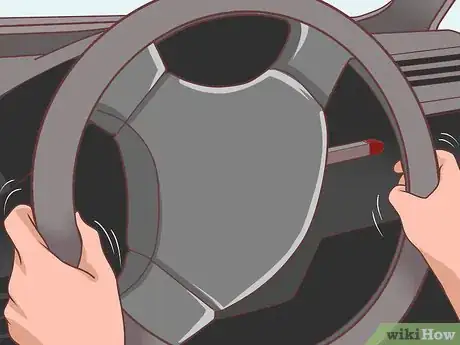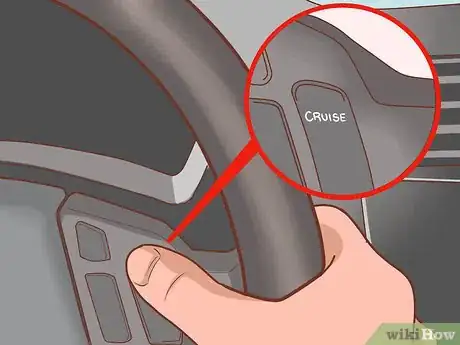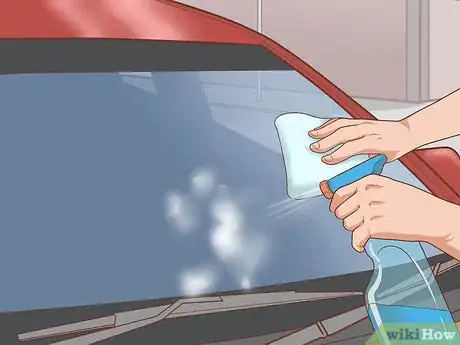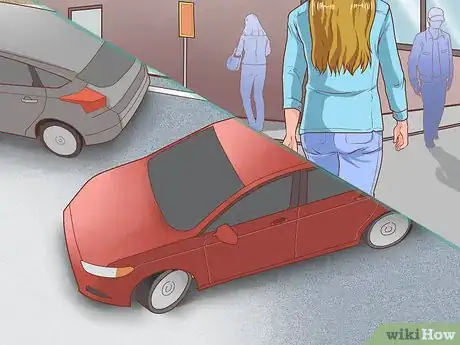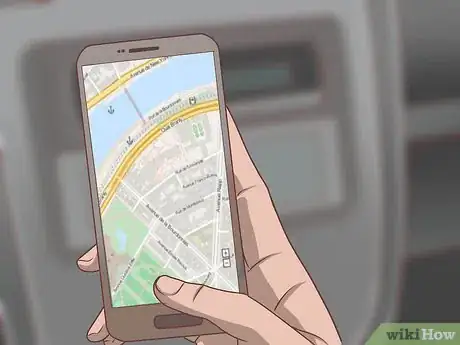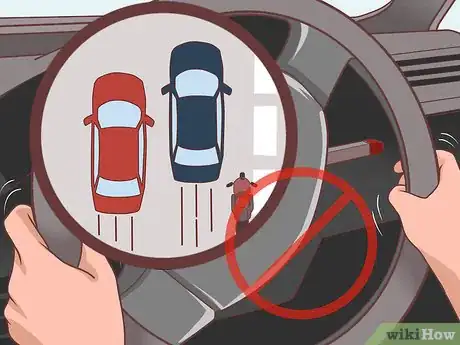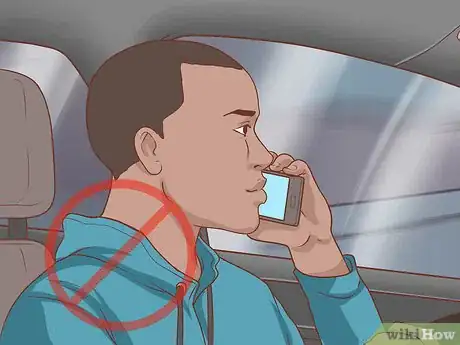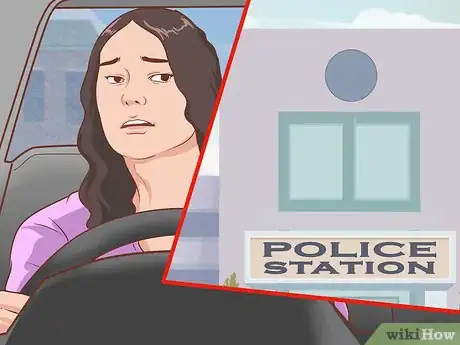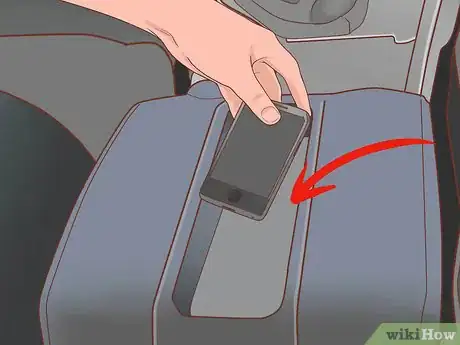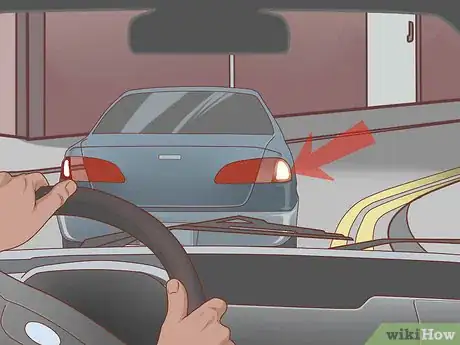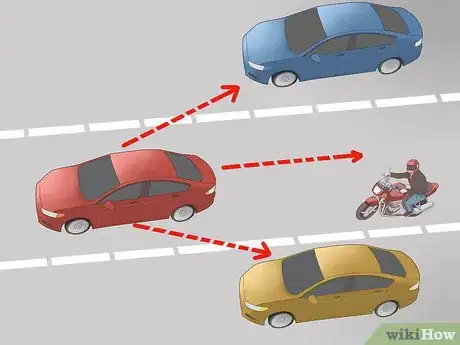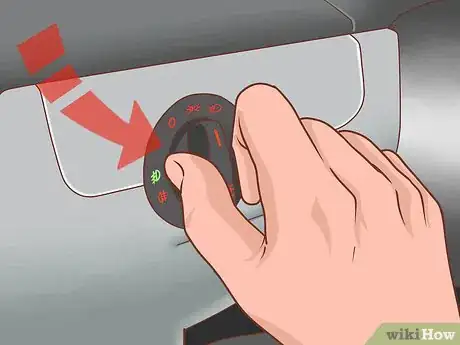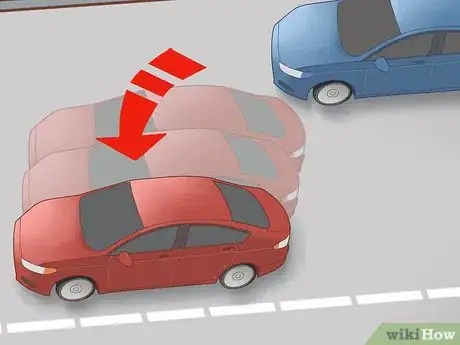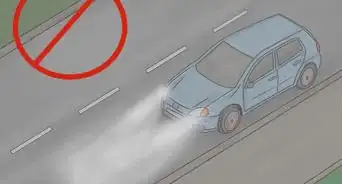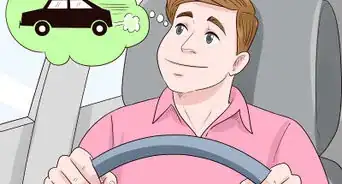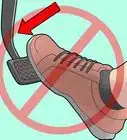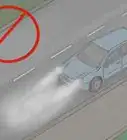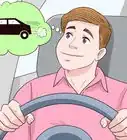This article was co-authored by Ibrahim Onerli. Ibrahim Onerli is a Driving Instructor and the Manager of Revolution Driving School in New York City. His mission is to make the world a better place by teaching safe driving. Ibrahim trains and manages a team of over eight driving instructors. He specializes in teaching defensive driving and stick shift driving.
There are 9 references cited in this article, which can be found at the bottom of the page.
This article has been viewed 95,058 times.
Road rage is classified as assault with a deadly weapon, the weapon being the enraged driver's car. Driving recklessly (or aggressive driving) without intent to cause harm is considered a traffic offense. A road rage incident is a criminal act. Learning how to control your own anger, and how to defuse or avoid the anger of other drivers will help avoid a potentially deadly traffic event.
Steps
Avoiding Feelings of Road Rage
-
1Keep your driving environment calm. Making your car a happy, peaceful place will help keep your road anger at bay. Listen to music that makes you happy or that calms you down. Creating a positive driving environment will help keep you calm during your commute and aid you in ignoring the road rage of others.[1]
- Listening to audio books is one good way to remain calm during a long commute.
-
2Allow yourself plenty of time. Being late will make you anxious and impatient, so you'll be more likely to get angry at other drivers or make irresponsible driving decisions that will make them angry at you. Leaving yourself plenty of drive time will help you stay relaxed.Advertisement
-
3Relax your grip. If you begin to clench the steering wheel while driving, wiggle your fingers and then try to hold the wheel with a more relaxed grip. You will retain control of the car, while feeling less tense.[2]
-
4Use cruise control. If your vehicle has cruise control and road conditions will allow it, using this feature will give your right leg a break and may make you feel less stressed.[3]
- You should only use cruise control in situations where you can drive safely at the same speed for extended periods of time – use manual control in stop-and-go traffic situations.
-
5Take a deep breath. If you feel yourself getting tense and anxious, take several slow, deep breaths. This should calm you down. Roll your window down every now and then, to let in some fresh air.[4]
-
6Keep your car and its windshield clean. Whether you are consciously aware of it or not, clutter can cause stressful feelings. Trying to see through a dirty windshield, or struggling to clean a dirty windshield with the wiper fluid every few minutes, will also cause you feel anxious and tense – feelings which can quickly lead to road rage.[5]
-
7Take a break if you need to. It's a good idea to pull over if you are feeling symptoms of road rage. Find a safe place to pull over and park, then get out and walk around for a few minutes until you feel more calm.[6]
- Never try to pull over on the side of a busy street or highway – continue to the next exit, then find a safe place to stop the car.
- Try not to drive more than 3 hours at a time. If you are on a long road trip, take a break at least every 3 hours and pull over to stretch your legs.
-
8Find alternate routes if necessary. If construction zones or rush hour highway traffic tend to make you edgy and more likely to express your road rage, find another way to get where you need to go. Use an online mapping system to look at alternate routes using calmer back roads that will make you less likely to get angry while driving.
-
9Get plenty of sleep. Doctors generally recommend that adults get about 8 hours of sleep per night. If you are sleeping less than this, the accumulated sleep loss will seriously affect your mood. Being tired can lead to anger, resentment, and annoyance, all of which contribute to road rage.[7]
-
10Avoid making driving a race or a contest. You're not trying to “win” anything when you are behind the wheel – you're trying to get where you're going, safely. Don't allow yourself to get drawn into contests with other drivers who want to race, or who dodge in and out of lanes trying to pass you.
- Some people enjoy passing you and then slowing down, for mysterious passive-aggressive reasons of their own. If possible, slow down enough to get behind a different car. Keep your distance from any driver who seems to be "playing games” with you.
-
11Avoid distractions. Don't talk on the phone, text message, eat, or apply lipstick while driving. This could cause you to be caught off guard by other drivers' actions, fueling your road rage and causing a dangerous incident.
-
12Shorten your commute. If you find yourself continually battling feelings of road rage, you may need to consider taking a different job or moving closer to your job, to shorten your commute. A high salary will not offset the unhappiness caused by spending too much time on the road, when you could be spending with family and friends, or engaging in activities you enjoy.[8]
-
13Take a road rage self-test. To find out whether your driving style is considered aggressive, take an online self-test. Being aware of your own tendencies toward road rage may make you more aware of the need to control it.
-
14Talk to your doctor. Some doctors believe that a condition known as Intermittent Explosive Disorder (IED) is responsible for road rage in certain people. Speak to your doctor if you continually experience feelings of anger or aggression, or have difficulty controlling your temper or your behavior.[9]
- IED may contribute to other factors such as depression, substance abuse, anxiety, and a difficulty maintaining healthy relationships.
- Your doctor may suggest therapy or medication to help control IED symptoms.
Dealing with Other People's Road Rage
-
1Avoid eye contact. Although it can be difficult not to react when someone is shouting at you, the best thing to do is ignore it. Keep your eyes on the road, and try not to make eye contact with the enraged driver.[10]
-
2Avoid escalation.[11] If an angry driver yells at you or shares a rude gesture out his or her window, don't shout back at them. Continue to drive as safely as possible ignore the angry driver. Fighting and driving angry is dangerous to both of you as well as the other drivers and will only cause the situation to escalate.[12]
- Roughly half of US drivers reported responding to an enraged driver by yelling back or making a rude gesture.
- As many as 37% of road rage incidents involve a firearm. This alone is an excellent reason to avoid road rage escalation.
-
3Remember that it's nothing personal. If another driver cuts you off or honks at you, it's because they're experiencing their own road rage, not because they are angry at you. Don't let it ruin your commute. Taking offense at his or her action will only cause your own road rage to escalate.
-
4Stay safe.[13] If you do become a victim of another driver's road rage and you feel threatened, take steps to keep yourself safe. Note the license plate number, make, and model of the vehicle in case the situation escalates and there is vehicle damage. If you're being followed, drive to the nearest police station and request assistance.
Practicing Good Driving Etiquette
-
1Be a polite driver.[14] Allow other drivers to pass you or get over into your lane if needed. Being courteous puts everyone in a more stable state of mind.
-
2Put your phone away. Talking or texting while driving is a terrible distraction that often causes accidents. Road rage can be triggered if an angry driver spots you using your phone in the car.[15] [16] [17]
- Cell phone usage causes more than 25% of auto accidents in the US.
- 13 US states and D.C. have laws prohibiting hand-held phone use while driving: California, Connecticut, Delaware, Hawaii, Illinois, Maryland, Nevada, New Jersey, New York, Oregon, Vermont, Washington, and West Virginia.
- Talking on a hand-held phone is also illegal in Puerto Rico, Guam, and the US Virgin Islands.
- 37 states and D.C. ban phone use while driving for novice drivers (drivers under a specified age – anywhere from 16 to 20, depending on the state).
- Texting while driving is even more dangerous than talking on the phone. If you're driving 55 mph and take your eyes off the road for 5 seconds to read a text, that's the equivalent of driving the entire length of a football field, while blindfolded.
-
3
-
4Check your blind spots. Twice. When changing lanes, especially at interstate highway speeds, be sure to look behind you and check any blind spots to make sure you aren't going to accidentally cut somebody off. Slotting into a lane carelessly and forcing the driver in that lane to slam on the brakes can easily spark road rage.[20]
-
5Lay off the horn. Excessive honking is a road rage trigger for many people, and it's just generally a rude thing to do. Your horn should only be used in rare situations when you need to alert another driver of your presence.
- Use your horn if another driver doesn't seem to see you while backing out of a parking space.
- Use your horn to alert another driver that your lane is occupied, if it looks like they are about to swerve into you.
- Do not use your horn because you're tired of sitting still in a traffic jam. Everyone else is equally annoyed, and using your horn will only make people angry. It won't alleviate the traffic.
- Do not use your horn to punish the driver in front of you if they don't immediately move when the light turns green. (If they continue to sit still, you can honk. Just try not to be obnoxious about it.)
-
6Be aware of your high beams. When it's dark out and you're using your high beams for increased visibility, always remember to switch over to regular beams when you spot an oncoming car. Being blinded by an inconsiderate person's high beams on a dark, deserted road is a recipe for road rage.[21]
-
7Resist the urge to brake sharply as a warning. When the car behind you is following too closely, don't slam on the brakes to “wake them up.” This often leads to a rear-end collision. Even tapping your brakes lightly, hoping the other driver will take the hint, can lead to a crash. Using your 4-way hazards when someone's narrowing the distance behind you, or if you see other hazards ahead, is safer than using your brakes right away as it helps alert everyone behind you. [22]
- When you are being tailgated (followed too closely for safety), move to a different lane if possible.
- If you can't change lanes, slow down gradually and allow the driver behind to pass you.
Expert Q&A
-
QuestionWhat are some ways I can avoid an aggressive driver?
 Ibrahim OnerliIbrahim Onerli is a Driving Instructor and the Manager of Revolution Driving School in New York City. His mission is to make the world a better place by teaching safe driving. Ibrahim trains and manages a team of over eight driving instructors. He specializes in teaching defensive driving and stick shift driving.
Ibrahim OnerliIbrahim Onerli is a Driving Instructor and the Manager of Revolution Driving School in New York City. His mission is to make the world a better place by teaching safe driving. Ibrahim trains and manages a team of over eight driving instructors. He specializes in teaching defensive driving and stick shift driving.
Driving Instructor The best thing you can do is continue driving as you normally would. Don't slow down or stop for them and avoid getting into any arguments.
The best thing you can do is continue driving as you normally would. Don't slow down or stop for them and avoid getting into any arguments.
References
- ↑ http://www.edmunds.com/car-reviews/top-10/top-10-tips-to-prevent-road-rage.html
- ↑ http://www.edmunds.com/car-reviews/top-10/top-10-tips-to-prevent-road-rage.html
- ↑ http://www.edmunds.com/car-reviews/top-10/top-10-tips-to-prevent-road-rage.html
- ↑ http://www.edmunds.com/car-reviews/top-10/top-10-tips-to-prevent-road-rage.html
- ↑ http://www.edmunds.com/car-reviews/top-10/top-10-tips-to-prevent-road-rage.html
- ↑ http://www.edmunds.com/car-reviews/top-10/top-10-tips-to-prevent-road-rage.html
- ↑ http://www.edmunds.com/car-reviews/top-10/top-10-tips-to-prevent-road-rage.html
- ↑ http://blog.penelopetrunk.com/2007/12/20/how-to-decide-if-your-commute-is-too-long/
- ↑ http://www.nimh.nih.gov/news/science-news/2006/intermittent-explosive-disorder-affects-up-to-16-million-americans.shtml
- ↑ http://www.safemotorist.com/articles/road_rage.aspx
- ↑ Ibrahim Onerli. Driving Instructor. Expert Interview. 18 November 2019.
- ↑ http://www.safemotorist.com/articles/road_rage.aspx
- ↑ Ibrahim Onerli. Driving Instructor. Expert Interview. 18 November 2019.
- ↑ Ibrahim Onerli. Driving Instructor. Expert Interview. 18 November 2019.
- ↑ http://www.businessinsider.com/cell-phones-causing-car-crashes-and-deaths-2015-5
- ↑ http://www.ghsa.org/html/stateinfo/laws/cellphone_laws.html
- ↑ http://www.ncsl.org/research/transportation/cellular-phone-use-and-texting-while-driving-laws.aspx
- ↑ Ibrahim Onerli. Driving Instructor. Expert Interview. 18 November 2019.
- ↑ http://www.safemotorist.com/articles/road_rage.aspx
- ↑ http://www.safemotorist.com/articles/road_rage.aspx
- ↑ http://www.safemotorist.com/articles/road_rage.aspx
- ↑ http://www.dot.state.mn.us/trafficeng/tailgating/FAQ.pdf
About This Article
The best way to avoid road rage is to keep yourself calm by creating a relaxing environment in your car. To do this, keep your car interior clean and avoid distractions, like talking on the phone. Alternatively, you can reduce the risk of triggering someone else’s road rage by keeping your eyes on the road and following all traffic laws, such as using your blinker to merge and driving the speed limit. Additionally, if someone is tailgating you, move to another lane or turn on your hazard lights. For more tips, like what to do if you feel threatened, read on!
